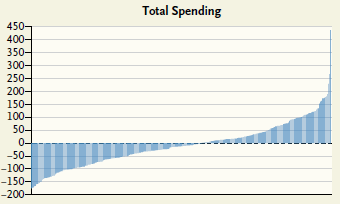Health policy wonks have been pointing for a while now to large variations in Medicare spending across different parts of the country. Live in Miami, and the government is probably going to spend a heck of a lot more for you on Medicare than if you live in Minneapolis, even after accounting for how healthy or sick you are. Here’s a picture demonstrating some of this variation from a recent article by Joseph Newhouse and Alan Garber in the New England Journal of Medicine.

The picture shows that some regions of the country spent almost $200 lessthan average, per month, per person while others spend almost $200 morethan average, per month, per person. (The really big spike on the right side is the city of Miami. No use trying to understand Miami!)
These variations have struck many policy experts as a chance for a win-win situation. As one group from Dartmouth put it: “To slow spending growth, we need policies that encourage high growth (or high-cost) regions to behave more like low-growth, low-cost regions.” This is a controversial claim, in part because the mere existence of variations doesn’t prove that high utilization, high-cost regions are spending too much on healthcare. It is possible that the low cost, low utilization regions are spending too little. Most people, who’ve looked closely at this topic, including me, believe that much of the spending in the high-cost regions is excessive, and can be curtailed without harming health significantly. The claim is also controversial because even if you were convinced that high spending regions are offering wasteful care to their patients, it’s not clear how to cut costs without harming patients, how to cut fat without also cutting meat… (Read more and view comments at Forbes)
